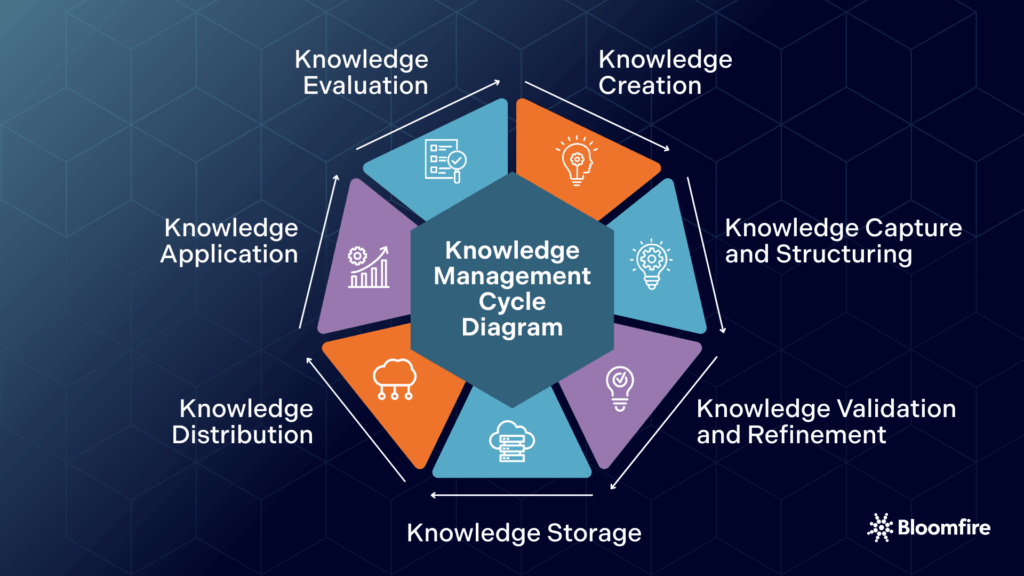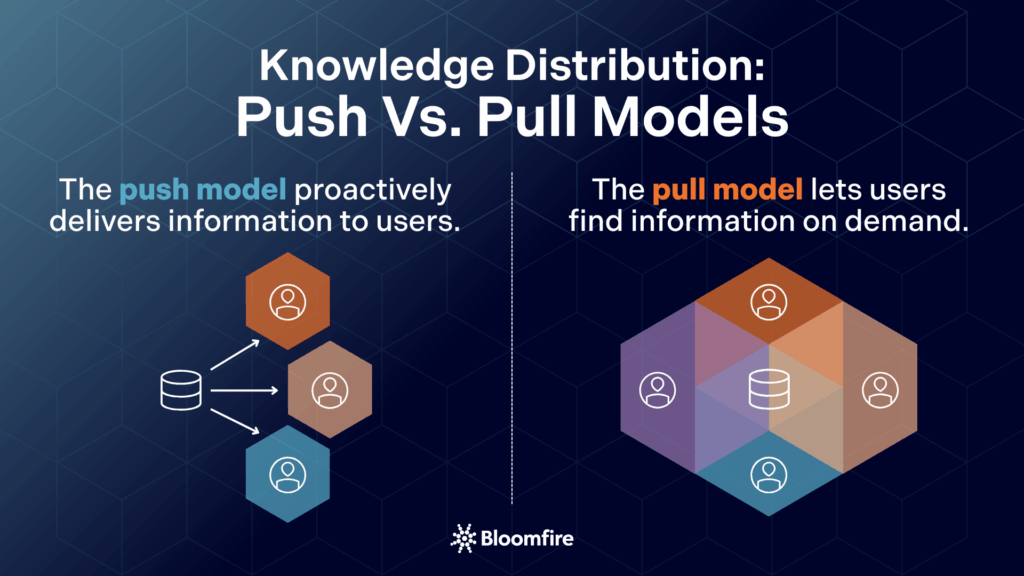Knowledge Management Cycle: From Theory to Real-World Implementation

Your organization can gain a competitive edge by effectively managing its knowledge assets, especially in the ever-changing world of information. The knowledge management life cycle provides a well-structured approach that encompasses the creation, capture, refinement, storage, distribution, and application of knowledge throughout your organization.
A properly implemented knowledge life cycle reduces redundancy and improves decision-making while encouraging breakthroughs. Your employees’ knowledge represents your most important strategic asset, as more executives now recognize.
Understanding the knowledge management system life cycle will help you put knowledge to work instead of letting valuable insights fade away. This piece walks you through each phase of the knowledge management cycle model, from theory to practice. Learn how to apply this knowledge to achieve tangible business results.

Phase 1: Knowledge Creation in Modern Organizations
The first step in developing a knowledge management system and strategy is knowledge creation. This phase builds your organization’s intellectual assets. Organizations that actively seek and create new knowledge tend to compete more effectively in the marketplace. This is because generating knowledge helps your organization develop new products, improve processes, and stay competitive in today’s knowledge-intensive landscape.
Sources of new knowledge: R&D, customer feedback, and innovation
Research and development (R&D) drives knowledge creation. Studies show that R&D activities help firms utilize external information more effectively and contribute substantially to innovation performance. Organizations with international R&D teams generate novel knowledge more effectively, which in turn improves innovation.
On the other hand, customer feedback provides another valuable source of knowledge. Customer opinions that are properly collected and analyzed help improve products and services.
Companies that use customer feedback can:
- Identify opportunities for product and service improvements
- Measure customer satisfaction, which closely relates to overall business performance
- Show customers that their opinions matter, which increases participation
- Improve customer retention by addressing concerns before customers leave
Innovation and knowledge creation work hand in hand. Innovation represents a key form of organizational knowledge creation that goes beyond simple information processing. Organizations create and define problems, then develop new knowledge to solve them, which sparks the designed continuity of an integrated knowledge management cycle.
Tacit vs. explicit knowledge in creation
The difference between tacit and explicit knowledge plays a vital role in knowledge creation. Explicit knowledge can be documented and communicated easily, showing only the tip of the iceberg of possible knowledge. Tacit knowledge has personal qualities that make it hard to formalize and communicate—it connects deeply to action, commitment, and involvement in specific contexts.
To maintain the life cycle of knowledge management, effective knowledge creation strategies must address both types. This is especially crucial in converting valuable tacit knowledge into explicit forms that can spread throughout your organization.
Role of collaboration in the knowledge management cycle
Collaboration speeds up knowledge creation. Knowledge creation works best as a collective process where participants contribute equally, address differences constructively, and stay open to emerging solutions. Scientific collaboration allows ideas to cross-pollinate, though it may cost more to coordinate.
Research shows that collaboration promotes knowledge creation by combining different viewpoints, encouraging open communication, and building ownership of outcomes. Modern organizations cannot invent successfully by relying only on internal knowledge—they need to explore and use external knowledge through partnerships.
Phase 2: Capturing and Structuring Knowledge Effectively
Knowledge capture plays a vital role in any knowledge management cycle. Employees spend about 20% of their workweek looking for information. Fortune 500 companies lose approximately $31.5 billion each year because of poor knowledge sharing. A well-laid-out process to capture and organize knowledge helps maintain your competitive edge.
Transforming Tacit Knowledge into Shareable Formats
As established above, your organization’s most valuable intellectual asset exists as tacit knowledge—personal insights, intuition, and expertise held in the minds of your employees. About 80-90% of organizational knowledge is tacit, while explicit knowledge makes up only 10-20%. You need systematic approaches to convert tacit knowledge into explicit, shareable formats (known as externalization).
Effective strategies to transform tacit knowledge include:
- Structured interviews and storytelling: Document subject matter experts’ insights and experiences through stories that convey complex ideas in relatable ways.
- Mentoring and apprenticeship programs: Establish formal mentorship programs where experienced employees share knowledge through hands-on collaboration.
- After-action reviews: Use structured discussions after projects to capture lessons learned and preserve valuable insights.
- Documentation of processes: Ask employees to create standard operating procedures that capture nuanced steps and decision-making criteria.
Capturing tacit knowledge can be challenging. However, through a knowledge management system, it can be documented and preserved without consuming too much time or incurring additional costs.
Tools for Knowledge Capture: Wikis, CRMs, and Documentation Systems
The right tools can enhance your knowledge capture capabilities. Internal knowledge bases act as centralized hubs to orchestrate and utilize your organization’s proprietary knowledge. These bases help transform tacit knowledge into explicit, readily available information.
Document management systems (DMS) focus on document lifecycle management. They use metadata tagging, version control, and access control lists to ensure data integrity. Content management systems (CMS) excel at creating, modifying, and publishing digital content through databases and templating engines.
Corporate wikis let everyone contribute directly to crowd-sourced knowledge building. Updates occur more frequently but may impact accuracy. Customer relationship management (CRM) systems capture valuable customer knowledge and improve service quality. A properly implemented CRM knowledge base reduces search time from 3-5 minutes to just 39 seconds.
Your knowledge capture tools should have strong search functionality, accessible navigation, easy editing capabilities, proper access rights management, and integration with other enterprise systems. These tools and structured approaches help your organization capture knowledge effectively and move to the subsequent phases of the knowledge management life cycle.
Knowledge Assets That Work for You!
Bloomfire can help you use your collective intelligence to increase your bottom line!
Let Our Expert Help!
Phase 3: Refining and Validating Knowledge Assets
The refinement phase in knowledge management is a quality control gateway that ensures only accurate information enters the knowledge ecosystem. The validation process turns raw knowledge into trusted assets. These assets help drive informed decisions across organizations.
Peer review and SME validation processes
Peer review is the lifeblood of knowledge validation. It promotes active collaboration between content authors and reviewers and starts the flow of new knowledge. This 30-year-old cooperation model follows three connected scenarios in sophisticated knowledge management systems:
- Traditional peer review, where recognized experts critique newly published knowledge assets
- Immediate feedback during knowledge interaction through user interface elements like knowledge buttons
- Notification-based reviews that keep relevant experts involved in specific knowledge assets’ lifecycle
Subject matter experts (SMEs) play a significant role in this validation process. They have a specialized understanding of the technical details needed for knowledge quality. Their key tasks include:
- Finding critical knowledge components and reviewing system designs
- Creating verification strategies and leading quality risk management
- Proving accuracy through structured review methods
Organizations that use formal peer review processes see significant improvements in knowledge quality. The data suggests assets going through peer review are more likely to meet quality standards compared to those without structured validation.
Ensuring the accuracy and relevance of captured knowledge
Knowledge validation needs ongoing assessment beyond the original validation. It consists of two complementary procedures: verification to test the completeness and consistency of knowledge, and evaluation to estimate the adequacy and reliability of knowledge.
Knowledge repositories need regular quality checks through user feedback sessions, surveys, and focus groups. These methods help learn how different teams use organizational knowledge and guide the required adjustments.
Transparent processes for version control, metadata management, and access permissions help maintain knowledge integrity over time. Automated workflows are one of the simplest yet most effective ways to simplify these validation processes.
The validation strategy should strike a balance between thoroughness and practicality. Organizations that use transparent and developmentally-oriented review processes encourage more knowledge contribution. Clear channels for feedback create a continuous improvement cycle throughout the integrated knowledge management system.
Phase 4: Storing Knowledge for Long-Term Access
Your knowledge assets need proper storage to retain their long-term value after you prove them right. A structured storage solution in your knowledge management life cycle will optimize operational efficiency.
Knowledge repositories and metadata tagging
Knowledge repositories function as online databases that systematically capture, organize, and categorize knowledge-based information. Your organization can store and retrieve captured knowledge easily with a centralized, available system.
Good repositories give you:
- Centralized hosting with simplified search functionality
- Protection of intellectual property through permission controls
- Integration with learning management systems
Metadata tagging makes knowledge much easier to find. This information-about-information element defines the context of your knowledge assets, their classification within a taxonomy, and their relationships with other information. The correct tagging helps employees find relevant content through filters and keywords. It improves organization by grouping related items and provides contextual understanding of the content’s purpose.
Version control and access permissions
Version control removes the need for ad-hoc naming conventions by tracking document changes systematically. The process automatically captures modifications as new document versions are created and incremented.
Version control lets your organization:
- Keep a detailed change history
- Include explanatory notes for each version
- Compare different versions to identify specific changes
- Roll back to previous versions when needed
Access permissions decide who can view knowledge (read access) and who can create or modify it (contribute access). The right access control policies will provide information only to intended audiences while maintaining security. You should think over the user criteria that determine access based on roles or other qualifications for sensitive knowledge.
Choosing between centralized vs. distributed storage
Centralized storage unites knowledge into unified systems that support multiple servers. This method makes sharing, protecting, and managing knowledge assets easier. Centralized systems are simpler to administer and maintain data consistency.
Distributed storage spreads knowledge across multiple nodes or locations. This approach scales better by adding more nodes and improves fault tolerance through data redundancy. Distributed systems also perform better through parallel data processing.
Your organization’s size, geographic distribution, and specific knowledge management cycle needs should guide your choice between these approaches. Many organizations ended up implementing hybrid solutions that utilize the strengths of both approaches within their knowledge management systems.
Phase 5: Distributing and Presenting Knowledge Across Teams
Your knowledge management cycle needs proper storage before you can share it effectively with others. The way you share and present knowledge will impact how effectively people adopt and utilize it throughout your organization.
Push vs. pull distribution models
Knowledge distribution works through push or pull models. Push distribution actively sends information to users through newsletters, alerts, and training materials whenever they ask for it. This approach will give a way to reach all employees who need critical information.
Pull distribution, on the other hand, lets users find information when they need it through knowledge bases or search systems. Research shows that visual learners process information more effectively with visual pull models compared to text-only approaches.

Visual formats: infographics, videos, and dashboards
Visual presentation of knowledge makes it much easier to understand and remember. American internet users (86%) turn to video to learn new information. Visual formats have several benefits:
- Videos: Almost three-quarters of training professionals now use video in their training delivery.
- Dashboards: Content owners use knowledge management dashboards to measure usage and quality while checking if proper processes are followed.
- Infographics: These visual tools communicate complex concepts clearly and keep people engaged, especially when sharing knowledge internally.
Integrating KM with communication tools (Slack, Teams)
Communication platforms today work as powerful knowledge-sharing hubs. Microsoft Teams does more than just communication – it works as a resilient knowledge base through dedicated channels, permission controls, and integration with tools like SharePoint.
Slack‘s built-in knowledge management features help teams capture, organize, and find information easily. A company using Slack for knowledge management can automate routine questions.
A knowledge management system like Bloomfire, which integrates with these critical tools, becomes a powerful solution for organizations as knowledge becomes readily available without leaving the platform. The integration naturally acts as an extension of your knowledge base.
Phase 6: Applying Knowledge to Drive Business Outcomes
Organizations achieve tangible business results when they successfully apply their acquired knowledge. Leading companies integrate knowledge sharing into their employees’ daily routines, rather than treating it as a separate activity.
Embedding knowledge into workflows and SOPs
Companies that embed knowledge management in business processes optimize their operations substantially. Direct integration of knowledge into workflows helps organizations save up to 40% on service costs.
Standard Operating Procedures (SOPs) serve as key knowledge management tools that document compliance procedures and lower regulatory violation risks. A well-laid-out knowledge management SOP helps improve efficiency by 30% and eliminates redundant work.
Phase 7: Knowledge Evaluation to Optimize Enterprise Intelligence
The seventh and final phase of the knowledge management cycle is knowledge evaluation. This critical stage closes the loop, shifting the focus from simply managing knowledge to proving its tangible value to the organization. Without proper evaluation, KM initiatives risk becoming costly, isolated projects that are disconnected from an organization’s strategic goals.
According to a McKinsey Global Institute study, companies that effectively leverage KM solutions can improve productivity by up to 25%. This doesn’t happen by accident–it’s the result of a deliberate and systematic evaluation process through periodic knowledge management audits.
Evaluating how knowledge is created, shared, and applied is essential for optimizing the impact of Enterprise Intelligence. Organizations can measure their collective intellectual assets, identify gaps, and ensure that every piece of information contributes to smarter, more effective business decisions.
Defining and measuring success with KPIs
The first step is to establish what success looks like by defining clear key performance indicators (KPIs). These metrics are the yardstick for measuring the impact of KM. They must be directly linked to business objectives, moving beyond simple engagement metrics like number of logins to actual business outcomes.
Example: A software company implements a new knowledge base for its customer support team. Instead of just tracking the number of articles created, the KM team would define and track KPIs like:
- Ticket deflection rate: The percentage of customer issues resolved by the knowledge base without needing a support agent’s intervention.
- First contact resolution (FCR): The percentage of customer issues solved on the first interaction, which can be improved by agents quickly finding the right information.
- Average handle time (AHT): The average time an agent spends on a single customer call. A well-organized customer support knowledge base should reduce this metric.
Conducting qualitative and quantitative analysis
Effective knowledge evaluation uses a dual approach. Quantitative data provides the “what” and “how much,” while qualitative feedback provides the “why” and “how well.” A complete picture requires both.
- Quantitative Analysis: This involves analyzing the complex numbers from your KPIs. For instance, a report might show that since launching a new internal wiki, the average time for a new employee to get up to speed on a project has decreased by 30%. This data provides a clear, measurable benefit.
- Qualitative Analysis: This involves gathering feedback through surveys, interviews, and focus groups. For example, a qualitative survey might reveal that while employees are using a new system, they find its search function frustrating. This “why” explains a low usage rate and points to a clear area for improvement.
A Harvard Business Review study found that organizations promoting knowledge sharing are five times more likely to be high-performing, a qualitative benefit often revealed through employee engagement surveys.
Demonstrating ROI and tying to business impact
The final and most crucial step is translating all this data into a compelling story for business leaders. The evaluation must demonstrate a clear return on investment (ROI). It’s not enough to show that people are using the knowledge base–you have to demonstrate how that usage translates into saved money, increased revenue, or reduced risk.
Here are key KM ROI metrics you can consider:
- Time saved searching for information
- Knowledge base usage metrics, including page views and search queries
- Self-service ratio (dividing self-service interactions by total support interactions)
- Customer satisfaction and Net Promoter Scores (NPS)
Example: A major manufacturing firm evaluated after implementing a KM system to capture expert knowledge. They found that by codifying best practices for machinery maintenance, they reduced unplanned downtime by 15% and cut maintenance costs by $500,000 annually. This clear business impact, derived directly from the evaluation process, justified the initial investment and secured further funding for KM initiatives.
Maintaining a Consistent Knowledge Management Cycle
Don’t look at knowledge management as just theory – call it a must-have business practice. Your organization’s intellectual capital is its biggest asset in today’s information-driven economy. A detailed knowledge management cycle isn’t just helpful; your business needs it to survive and thrive. Organizations that carry out these phases gain a clear edge over their competitors.
Unlock Your Enterprise Intelligence
Turn scattered information into useful knowledge that propels business success.
Learn More

Enterprise AI Search: Definition, Benefits, and Evolution

The Benefit of Company-Wide Knowledge Management in 2026

Are You Making These Common Knowledge Sharing Mistakes?

Estimate the Value of Your Knowledge Assets
Use this calculator to see how enterprise intelligence can impact your bottom line. Choose areas of focus, and see tailored calculations that will give you a tangible ROI.

Take a self guided Tour
See Bloomfire in action across several potential configurations. Imagine the potential of your team when they stop searching and start finding critical knowledge.